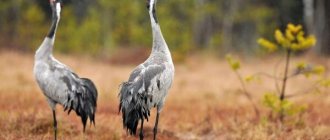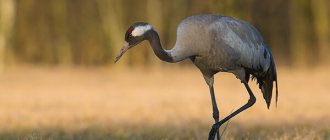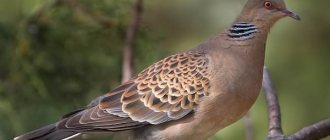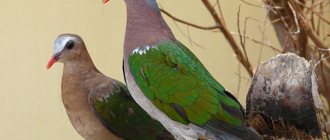Cranes, unlike storks and herons, build nests on the ground, collecting dry grass in a flat pile and making a depression at the top. They usually have 2-3 spotted brownish or greenish eggs in their clutch. Since the nests of these birds are located on the ground, their chicks are of the brood type - having hatched from the egg and dried out a little, the little cranes almost immediately leave the nest and follow their parents in search of food. After this, the crane family does not return to the nest.
general characteristics
Cranes are incredibly graceful birds due to the anatomical features of their structure. Adults can reach a length of 1-1.8 meters and weigh 2-11 kg. The wingspan of a crane can reach 240 cm, which makes their flight majestic and mesmerizing. Gray cranes boast the largest wingspan, reaching almost 250 cm.
The very structure of the cranes’ body visually creates the correct proportions for them: the long parts of the body, neck, torso, and legs form three equal parts of the body, although in reality this division is relative. The presence of a long beak complements the image. The color of birds directly depends on their variety, but for the most part it is formed by a gray-white color. In young individuals, the gray is usually mixed with a brown tint.
The crown is the area whose color depends more than others on the species characteristics of the bird. Based on this indicator, feathers can be bright, faded, long or completely absent.
The unusual crown is a characteristic feature of the crane.
The neck and head area of cranes is usually black with an adjacent white stripe. From a distance, the birds appear to have a large fluffy tail, but upon closer inspection, it becomes clear that this is an illusion created by protruding feathers. The tail feathers themselves are not too long.
Males and females practically do not differ from each other in appearance. Moreover, males are slightly larger than females. In addition, the female’s body is less dense and the beak is shorter. Males also have stronger and longer legs.
Elena
Ask a Question
Question to the expert
How long do cranes live on average?
Cranes are considered to be the true long-lived birds. Their lifespan depends on the variety and habitat. In the natural environment, most cranes live to be 25-30 years old. Moreover, in nature reserves their life expectancy can reach 40 years. There is a documented case of evidence of the longest life expectancy among cranes - 87 years. This figure has been achieved by the rare Japanese crane, whose population is currently listed in the Red Book.
Where do cranes live in the wild?
There is a theory that cranes originally lived in the territory of modern North America and Africa, from where they subsequently moved to other continents. Currently, cranes are found in almost all corners of the globe, not counting Latin America and Antarctica.
In Russia, 7 species of birds live permanently and pass through. The largest population in the country is Gray Cranes.
To live, cranes choose open areas near bodies of fresh water. The nesting sites must certainly have marshy areas and floodplain meadows.
The distribution patterns of cranes depend on their species. Thus, Black Cranes settle near taiga swamps, choosing places with a lot of trees to live. Sandhill cranes settle near salt lakes.
Previously, cranes were widespread throughout Europe, but now their habitat has been reduced to the northeastern parts, and is also limited to the region of eastern Siberia. In European countries, cranes are found mainly during migratory times, when a flock flies to warmer climes. They spend their wintering in the southern part of France, Spain and Africa. Birds often stop in northern Germany during their flights.
Interesting facts about the bird
A pair of white-naped cranes is still considered today one of the symbols of wealth, prosperity and longevity in love and abundance. The White-naped Crane is one of the key symbols in Feng Shui. There was an interesting tradition in the north of the Japanese island of Hokkaido. Women from the ancient Ainu tribe, whose cultural traditions were more closely associated with Siberia than with Japan, performed a special “crane dance”. It was a kind of ritual that promised the newlyweds a long and happy life. In Yakutia, the belief has survived to this day that even the accidental killing of a crane or the destruction of its nest inevitably brings misfortune.
The name of the flower “geranium” comes from the ancient Greek word Γερανος - “crane”. This is not surprising, because the geranium fruit is very similar to the beak of a crane. In Russia, there has long been a belief that the first person to see the crane dancing in the spring will be the happiest in the coming year.
What do cranes eat in the wild?
Cranes are omnivorous birds that eat both plants and small animals. Plant food sources for them include grass, seedlings, leaves, plant roots, seeds, and tubers. Cranes are also partial to legumes, cereals, and berries.
They especially prefer potatoes and corn. Food of animal origin is most often obtained by adults for their offspring. The chicks are fed:
- Worms.
- Snails.
- Insects.
- Shellfish.
- Crustaceans.
Adult cranes may also feed on lizards and toads.
Lifestyle and behavioral characteristics
Cranes are most active during the daytime. As soon as the sun rises, they begin searching for food. When the day begins to set, the birds immediately go to the shelter and fall asleep there. Cranes usually sleep on one leg while standing in shallow water. These are extremely careful birds that will not allow strangers to sneak up on their habitat. When strangers approach, they instantly fly away, notifying their comrades of the arrival of people, other birds or animals.
Cranes are able to distinguish the appearance of strangers at a distance of 300 meters.
The flight of birds begins with their run-up, during which they open their wings, straighten their necks and push off from the ground in one jump.
During flight, the birds stretch out in one line, thanks to which they are able to maintain speeds of more than 60 km/h. During periods of migration, birds fly following the leader. They may not stop on the way for several days, as the birds are distinguished by great endurance. Their flight altitude is approximately one kilometer.
When faced with a strong wind, cranes line up in a wedge
Recommended by topic
Blackbirds Woodpecker Heron
Birds prefer to rest in quiet and swampy places. During the flight, they can stay there for 7-10 days to regain their strength. After this, the flock again resumes its long journey.
At the same time, birds do not like to leave their home and prefer to live in the same place for a long time. After wintering, they strive to return to the old nest and modify it to breed offspring. Circumstances forcing cranes to leave their homes are associated with a lack of food or changes in the usual climate.
Cranes are highly clean and devote a large amount of time to cleaning their feathers. They often spend time near bodies of water, which is why they are rarely dirty. However, it is important for birds to maintain hygiene.
Social structure
Cranes live in flocks and all settle in one place. In the neighborhood there can be from 100 to 200 pairs, each of which builds its own nest. The flock prefers to settle in a secluded place, located away from cities and roads, but sometimes cranes nest not far from people.
Cranes are monogamous birds, choosing a partner once for their entire lives. The search for a new partner occurs only in the event of the death of the previous “spouse”. A characteristic feature of cranes is that they search for a partner during the wintering period, and not after returning, like other birds.
Cranes do not rest in trees or on the ground, as they can be attacked there by birds of prey and animals. Shallow water becomes the main resting place for birds.
Living in a flock gives cranes a number of advantages. While the rest of the birds are feeding, several guards are watching what is happening in the area. If an enemy appears on the horizon, the birds warn the others about this so that the flock can leave the area as soon as possible.
Question to the expert
Why don't cranes sit in trees?
This behavior is due to the anatomical features of cranes. Their legs are not designed for perching on branches: their toes are not able to wrap around them in such a way that the birds can maintain one position. Sitting on branches is not an evolutionary necessity for birds due to the fact that they have always preferred to rest near water. However, crowned cranes live in Africa, which, unlike their counterparts, have a grasping finger located at the back. Thanks to it, they are able to stay on trees, fences and other surfaces.
Crane's home
The partners are engaged in the construction of housing together. The nest is usually located on small hills near bodies of water. It is formed from moss, peat, dry thin branches and twigs. All materials are fastened together using blades of grass. The formed dwelling looks like a small bowl, the diameter of which does not exceed one
Modern research
An adult demoiselle crane with a ring and a GPS-GSM transmitter.
08/22/2019. Photo by V.P. Belik To study the current distribution and abundance of belladonna in the south of Russia, as well as to clarify the limiting factors in 2022, from May to August, we conducted a series of comprehensive expeditionary studies in the Rostov and Volgograd regions, in the Stavropol Territory, in Kalmykia and Crimea. In parallel, within the framework of the international project “1000 Cranes”, the work started back in 2017–2018 was continued. tagging of cranes with colored rings and GPS-GSM transmitters with a solar battery, which make it possible to monitor the movements of birds throughout the year at nesting sites, on migration routes and in wintering areas.
In the spring of 2022, five belladonna nests were found in Kalmykia and the Rostov region, near four of which one adult bird was caught and marked with colored rings and GPS-GSM loggers to study their behavior in the broods. In the summer, another 27 belladonna belladonnas were equipped with transmitters, including seven adult birds and one young one, which were caught in August at the site of a pre-migration aggregation of cranes in the Manych valley in the Stavropol Territory, and 19 chicks aged from 35 to 50 days: four chicks were found in June in the Rostov and Volgograd regions, nine in Crimea and two in Kalmykia.
Demoiselle chick, 35–40 days old, in a threatening pose. Kalmykia. 06/26/2019. Photo by E. I. Ilyashenko
In total, in 2022, we tagged 31 demoiselle cranes with loggers, and signals began to be received from 24 of them. They regularly register on the international website Movebank
, where all the tracking data for various animals from many other scientific projects around the world is accumulated.
Recent studies have shown [] that in Crimea belladonnas have been preserved mainly in only two isolated areas - in the steppes on the Kerch and Tarkhankut peninsulas, and in the first of them a focal distribution of birds has been noted: in the Osovinskaya Steppe reserve, in the Karalarsky natural park and in the area of the Opuksky Nature Reserve, where 5 pairs per 5 km2, 7 pairs per 24 km2 and 3 pairs per 4 km2 were recorded, respectively. of the Kerch Peninsula
Most of the territory is now occupied by agricultural land, and therefore the belladonna population density is much lower. In 2019, only one pair with chicks and two without offspring were counted there, but in total 18 pairs were found on the Kerch Peninsula, 10 of them with broods.
A pair of demoiselles with downy chicks in a typical habitat. Volgograd region, Ergeninskaya Upland. 06/23/2009. Photo by E. V. Gugueva
On the Tarkhankut Upland in the west of Crimea, the distribution of belladonnas is more uniform, since quite large areas of low-grass rocky steppe, unsuitable for plowing, have survived there. In total, 17 pairs were counted on Tarkhankut in 2022, 6 of them with chicks. Another 8–10 pairs of belladonnas belonging to the Crimean group also nested on the Taman Peninsula in the Krasnodar Territory [].
In the Northern Azov region in the southwest of the Rostov region, where in the 1980s belladonnas lived in fields with a density of up to 1 pair per 100 km2 [, ], in the summer of 2022 they could not be detected. According to survey data, they disappeared there after the abandonment of the last livestock farms in the steppe gullies. These birds were not found in the Kalach bend of the Don in the Volgograd region, where more than 400 km of road routes were covered in search of cranes, although in 1997 and 2009. the abundance of belladonna there ranged from 0.83 to 0.45 pairs per 100 km2 []. Among the likely reasons for the disappearance of cranes in these areas is the intensive meadow formation of steppes associated with climate change, as well as the overgrowing of pastures with tall grasses and shrubs due to the low number of livestock, the number of which decreased here in the 1990s by approximately an order of magnitude.
Even in the dry steppes and semi-deserts of Kalmykia, where the largest Caspian population in Europe lives, which was recently estimated at 14-18 thousand pairs, its numbers have decreased - according to our 2022 records, at least three to five times compared with the beginning of the 21st century. [, , ]. Thus, the abundance of belladonnas in Kalmykia in 1984–2003. was 20–45 nesting individuals per 100 km2 in the steppes on Ergeny, 30–51 individuals per 100 km2 in semi-deserts and 21–53 individuals per 100 km2 in the deserts of the Caspian lowland []. In the Manych valley in the Rostov region. in the 1990s, up to 15 pairs nested per 100 km2 []. Back in 2003–2009. on the Ergeninskaya Upland, in the Caspian Lowland and the Kuma-Manych Depression in the territory of Kalmykia, Dagestan, Stavropol Territory and Volgograd Region. the abundance of these birds varied in different conditions from 3.7 to 35.3 pairs per 100 km2 [].
However, in 2022 on Ergeni we counted only 1.6 pairs per 100 km2, which is three to four times less than at the end of the 20th and beginning of the 21st centuries. In the Manych valley at the end of June 2022, 4.4 pairs per 100 km2 were recorded, i.e. three times less than in the 1990s, and in early July, on dry, waterless steppe ridges along the salt lake Manych-Gudilo, only one belladonna was found along 107 km of the route, i.e. less than 0.5 pairs per 100 km2.
The valley of the Tuzlov River above the village of Chistopolye in the south of the Rostov region, overgrown with tall grass and shrubs. 06/23/2019. Photo by E. I. Ilyashenko
Reproduction and raising of offspring
Migratory cranes return to their previous nesting site in late February and early March. Once they have settled in, the breeding season begins. This moment occurs in birds closer to four years - the age when cranes reach the stage of sexual maturity.
Already established married couples go to winter together and fly back to the nests together.
If males fail to attract the attention of females during wintering, they do so in early spring. Males begin to strive to win the attention of a potential partner through courtship. This process is accompanied by a kind of dance, in which the male seems to bow to the chosen one, stretches his neck, waves his arms, and makes jumps. Usually the dance is accompanied by loud sounds, which during the mating season are similar to a melodic combination of the syllables “sko-ko-sko”.
After mating, the female lays about 3 eggs in late April, the color of which can be red-brown, gray-brown or olive, depending on the variety of bird. The minimum number of eggs for one clutch is 2, but some species can lay more than 5 eggs. Next, the incubation period begins, which lasts about a month. Both parents take turns doing incubation. While one spouse goes to get food, the second guards the nest and future offspring.
While hatching, some species of cranes try to camouflage themselves from predators and use mud to do this. Thus, the Gray Crane covers its feathers with mud in order to remain invisible to its enemies.
Caring for the Cubs
The chicks hatch one after another, the difference between them is usually several days. After birth, they are already covered with a small light gray down, which is gradually replaced by feathers over several months.
As soon as they learn to walk, the babies no longer sit in the nest, but follow adults everywhere. This happens within a couple of days after birth, as the chicks develop quickly. When the parents find any food, they immediately pass it on to the chicks, who follow them everywhere.
Usually the chicks are separated by parents: one part goes with the father, the other with the mother.
After the offspring are 2.5 months old, the young individuals finally leave the nest and stop maintaining contact with their parents.
Lifestyle
These graceful and proud birds are most often monogamous. But there are known cases of individuals going “to the left”, to another partner.
Cranes build meter-long platform nests in shallow water and usually lay 2 eggs at a time. Both parents help raise the chicks, which stay with them until the next breeding season.
Cranes are gourmets. Birds' diet may vary depending on the season and personal needs. They eat a wide range of foods: from small rodents, fish, amphibians and insects to grains and berries.
Natural enemies
Birds have a lot of natural enemies, but adult birds are considered quite intelligent and cautious, and therefore rarely fall into the clutches of predators. Most often, their victims are still fragile chicks, who are attacked by predators who destroy the nests of cranes, eating their eggs and offspring. Thus, nest destruction and hunting can be carried out by:
- Eagles.
- Hawks.
- Foxes.
- Golden Eagles.
- Boars.
- Wolves.
Adult birds practically do not allow themselves to be caught by surprise, since they are quite large, fast-flying and cautious. Whenever a threat appears, they give a loud sound signal, warning their relatives of the danger.
One of the main enemies is the hawk
If predators find themselves close to a couple’s nest in which the offspring lives, one of the parents tries to take it away from there. This happens by simulating a wound, with which the crane distracts the attacking enemy.
In addition to wild animals, the crane population is also threatened by human activities. Due to human actions, the natural habitat of birds is being destroyed, as a result of which they are forced to migrate, looking for new places for food and nesting. People often drain swamps to get new land for farming. This drives birds away from their homes.
In addition, cranes often encroach on sown fields: the birds eat young shoots of grain crops. In temperate climates this is usually not a problem as there is plenty of plant and animal food in the area. However, in Africa, where the climate is hot and dry, there is much less food, which poses a threat to life. Because of this, cranes often raid farms, while farmers themselves try to drive the birds away. Often this ends in the targeted destruction of birds, despite the fact that formally shooting cranes is prohibited.











